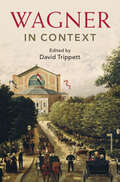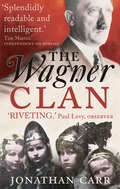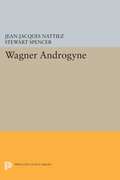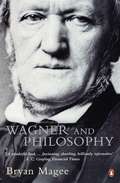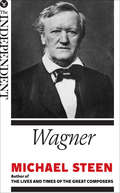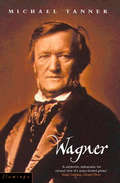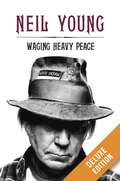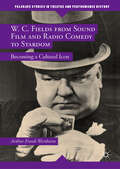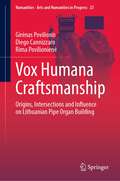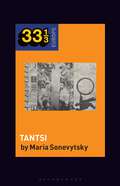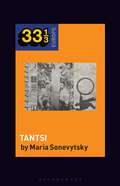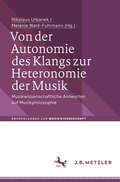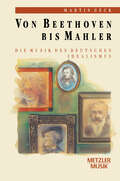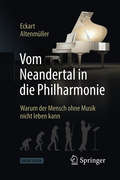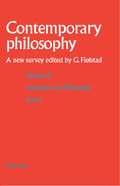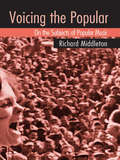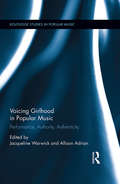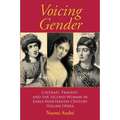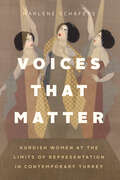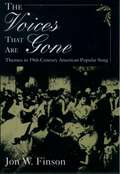- Table View
- List View
Wagner in Context (Composers in Context)
by David TrippettFew composers embodied wider cultural interests than Wagner or had greater cultural consequences. This is the first collection to examine directly the rich array of intellectual, social and cultural contexts within which Wagner worked. Alongside fresh accounts of historical topics, from spa culture to racial theory, sentient bodies to stage technology, America to Spain, it casts an eye forward to contexts of Wagner's ongoing reception, from video gaming to sound recording, Israel to Friedrich Kittler, and twenty-first century warfare. The collection brings together an international cast of leading authorities and new voices. Its 42 short chapters offer a reader-friendly way into Wagner studies, with authoritative studies of central topics set alongside emerging new fields. It sheds new light on previously neglected individuals such as Minna Wagner, Theodor Herzl and Houston Stewart Chamberlain, and investigates/assesses/examines the global circulation of Wagner's works, his approach to money, and the controversies that continue to accompany him.
The Wagner Clan: The Saga Of Germany's Most Illustrious And Infamous Family
by Jonathan CarrFor over a century the Wagners have presided over the Bayreuth Festival, playing host to many of the greatest and ghastliest figures in the arts and politics amidst family in-fighting and political controversy. Drawing on extensive interviews with members of the family and on both archive and recent material, Jonathan Carr presents a balanced but gripping portrait of the Wagners and their circle; a story which presents a mirror of Germany's rise, fall and resurrection.
Wagner Androgyne
by Jean-Jacques Nattiez Stewart SpencerThat Wagner conceived of himself creatively as both man and woman is central to an understanding of his life and art. So argues Jean-Jacques Nattiez in this richly insightful work, where he draws from semiology, music criticism, and psychoanalysis to explore such topics as Wagner's theories of music drama, his anti-Semitism, and his psyche.Wagner, who wrote the libretti for the operas he composed, maintained that art is the union of the feminine principle, music, and the masculine principle, poetry. In light of this androgynous model, Nattiez reinterprets the Wagnerian canon, especially the Ring of the Nibelung, which is shown to contain a metaphorical transposition of Wagner's conception of the history of music: Siegfried appears as the poet, Brunnhilde, as music, and their union is an androgynous one in which individual identity fades and the lovers revert to a preconflictual, presexual state.Nattiez traces the androgynous symbol in Wagner's theoretical writings throughout his career. Looking to explain how this idea, so closely bound up with sexuality, took root in Wagner's mind, the author considers the possibility of Freudian and Jungian interpretations. In particular he explores the composer's relationship with his mother, a distant woman who discouraged his interest in the theater, and his stepfather, a loving man whom Wagner suspected was not only his real father but also a Jew. Along with psychoanalysis, Nattiez critically applies various structuralist and feminist theories to Wagner's creative enterprise to demonstrate how the nature of twentieth-century hermeneutics is itself androgynous.Originally published in 1993.The Princeton Legacy Library uses the latest print-on-demand technology to again make available previously out-of-print books from the distinguished backlist of Princeton University Press. These editions preserve the original texts of these important books while presenting them in durable paperback and hardcover editions. The goal of the Princeton Legacy Library is to vastly increase access to the rich scholarly heritage found in the thousands of books published by Princeton University Press since its founding in 1905.
Wagner and the Erotic Impulse
by Laurence DreyfusThough his image is tarnished today by unrepentant anti-Semitism, Richard Wagner (1813–1883) was better known in the nineteenth century for his provocative musical eroticism. In this illuminating study of the composer and his works, Laurence Dreyfus shows how Wagner’s obsession with sexuality prefigured the composition of operas such as Tannhäuser, Die Walküre, Tristan und Isolde, and Parsifal. Daring to represent erotic stimulation, passionate ecstasy, and the torment of sexual desire, Wagner sparked intense reactions from figures like Baudelaire, Clara Schumann, Nietzsche, and Nordau, whose verbal tributes and censures disclose what was transmitted when music represented sex. Wagner himself saw the cultivation of an erotic high style as central to his art, especially after devising an anti-philosophical response to Schopenhauer’s “metaphysics of sexual love.” A reluctant eroticist, Wagner masked his personal compulsion to cross-dress in pink satin and drench himself in rose perfumes while simultaneously incorporating his silk fetish and love of floral scents into his librettos. His affection for dominant females and surprising regard for homosexual love likewise enable some striking portraits in his operas. In the end, Wagner’s achievement was to have fashioned an oeuvre which explored his sexual yearnings as much as it conveyed—as never before—how music could act on erotic impulse.
Wagner and Philosophy: Wagner And Philosophy
by Bryan MageeWagner was one of the few major composers who studied philosophy seriously. Bryan Magee places the composer's artistic development in the context of the philosophy of his age, and gives us the first detailed and comprehensive study of the close links between Wagner and the philosophers - from the pre-Marxist socialists to Feuerbach and Schopenhauer. Magee explores the relationship between words and music, between the conscious and the unconscious mind, between art and philosophy. It tackles soberly and judiciously the Wagner whose paranoia, egocentricity and anti-semitism are repugnant, as well as the Wagner of artistic genius. The resulting text illuminates Wagner and the music-dramas in altogether new ways.
Wagner: The Great Composers (The Great Composers)
by Michael SteenWelcome to The Independent’s new ebook series The Great Composers, covering fourteen of the giants of Western classical music. Extracted from Michael Steen’s book The Lives and Times of the Great Composers, these concise guides, selected by The Independent’s editorial team, explore the lives of composers as diverse as Mozart and Puccini, reaching from Bach to Brahms, set against the social, historical and political forces which affected them, to give a rounded portrait of what it was like to be alive and working as a musician at that time. No other composer is at once so revered or so reviled as Richard Wagner. Yet his contribution to opera is immense. His reputation rests on ten epic operas which are constantly performed worldwide, without speaking of the annual festival of his music at Bayreuth, the opera house which he designed and built to stage his works. Four of these operas, Das Rheingold, Die Walküre, Siegfried and Gotterdammerung, make up the monumental 15-hour Ring cycle, based on old Norse-Germanic sagas. Many of the others hark back to medieval and Arthurian legends, often dramatising the conflict between the sacred and profane, the sensual and spiritual. Using leitmotifs – themes which symbolise characters and elements in his opera – Wagner introduced a new musical vocabulary. Endless affairs, twice married, constantly on the run for either political or financial reasons, a prolific writer, an indefatigable composer, Wagner was also, as Michael Steen's narrative shows, a monster of egoism. A revolutionary in his youth, Wagner escaped to Zurich, only to be forced to move on when the businessman bankrolling him was about to uncover Wagner's affair with his wife. He was then lavishly supported in Munich by the ‘Mad King’ Ludwig II of Bavaria, until the king's ministers objected. Once in Switzerland, Wagner was joined by Cosima von Bülow, Liszt's daughter and the wife of a conductor, who became his second wife and helped him realise his dream at Bayreuth.
Wagner
by Michael Tanner‘A fine, intellectually sparkling and always engaging little book – a welcome addition to any Wagner library’Hans Vaget, Opera Quarterly
Waging Heavy Peace Deluxe: A Hippie Dream
by Neil YoungThe deluxe eBook edition of Waging Heavy Peace includes excerpts of more than fifteen Neil Young songs (personally selected by Young himself) such as "After the Gold Rush," "Like a Hurricane," and "The Needle and the Damage Done," providing a soundtrack to his stories. Interspersed throughout the text are ten rare Young videos from his own archives, offering an uncommon behind the scenes glimpse of the man behind this memoir. In addition, a complete discography guarantees that diehard devotees and new fans alike enjoy the ultimate Neil Young experience. For the first time, legendary singer, songwriter, and guitarist Neil Young offers a kaleidoscopic view of his personal life and musical creativity. He tells of his childhood in Ontario, where his father instilled in him a love for the written word; his first brush with mortality when he contracted polio at the age of five; struggling to pay rent during his early days with the Squires; traveling the Canadian prairies in Mort, his 1948 Buick hearse; performing in a remote town as a polar bear prowled beneath the floorboards; leaving Canada on a whim in 1966 to pursue his musical dreams in the pot-filled boulevards and communal canyons of Los Angeles; the brief but influential life of Buffalo Springfield, which formed almost immediately after his arrival in California. He recounts their rapid rise to fame and ultimate break-up; going solo and overcoming his fear of singing alone; forming Crazy Horse and writing "Cinnamon Girl," "Cowgirl in the Sand," and "Down by the River" in one day while sick with the flu; joining Crosby, Stills & Nash, recording the landmark CSNY album, Déjà vu, and writing the song, "Ohio;" life at his secluded ranch in the redwoods of Northern California and the pot-filled jam sessions there; falling in love with his wife, Pegi, and the birth of his three children; and finally, finding the contemplative paradise of Hawaii. Astoundingly candid, witty, and as uncompromising and true as his music, Waging Heavy Peace is Neil Young's journey as only he can tell it.
W. C. Fields from Sound Film and Radio Comedy to Stardom: Becoming a Cultural Icon (Palgrave Studies in Theatre and Performance History)
by Arthur Frank WertheimW. C. Fields is known as a virtuoso comedian and legendary iconoclast who gave the gift of laughter to multitudes. As the first author to use the newly-opened Fields Papers at the Academy library, Arthur Frank Wertheim illuminates the comedian’s arduous ascent to stardom during Hollywood's golden age. The book reveals details of Fields’s turbulent private life, from his wife's refusal to divorce, to his estranged son, and to his fleeting relationships with women. Here is a portrait of an aggrieved artist whose emotional anguish found refuge in his poignant comedy about life’s frustrations and the human condition. This third volume in Wertheim's trilogy documents Fields's rise to iconic status during the counterculture 1960s, creating a legacy of his comedy for generations to come.
Vox Humana Craftsmanship: Origins, Intersections and Influence on Lithuanian Pipe Organ Building (Numanities - Arts and Humanities in Progress #23)
by Girėnas Povilionis Diego Cannizzaro Rima PovilionienėThis book provides a thorough analysis focused on the sound expression produced by human-crafted musical instrument – a pipe organ, in which various components blend into a complex whole to produce a wide range of timbres. The sound produced by wooden and metal pipes of a variety of sizes is an integral part of the instrument’s unique character, while the organ stop is like its signature, from which one can judge about the size and style of the instrument, an organ building school or even an organ master, to which it is attributable. Precise identification of the name of the stop in accordance to both the pipework itself and the authentic inscriptions on the pipes is instrumental in investigating the geographic origins and authorship of an organ. The monograph focuses on the craftsmanship of complex and historically influential organ stop Vox humana. Its research and definition provides specific information distinguishing particular features in the variety of organ building traditions and discussing the differences in organ sound perception and production. The volume is aimed at art and music historians, as well as musicologists and scholars researching restoration techniques.The book contains supplemental material with video and audio material as well as photo-documentation of authentic Vox humana examples. The material is placed in the online catalog, which may be accessed by scanning the QR code in the appendix of the book.dsgdsgds
Vopli Vidopliassova’s Tantsi (33 1/3 Europe)
by Maria SonevytskyRock 'n' roll may not have toppled the USSR, but it definitely rumbled through its foundations. Unlike the often-saccharine pop music sanctioned by the Soviet state, Ukrainian punk musicians of the 1980s Kyiv underground adapted ideologies of rock to roast the absurdities of late Soviet life, to articulate new ways of being Ukrainian, and to celebrate the cathartic pleasures of collective gatherings organized around musical performances. This book tells the story of Tantsi (Dances) a 1989 semi-official cassette release by the now-legendary Ukrainian punk band Vopli Vidopliassova, known to fans simply as VV (pronounced “Ve-Ve”). Their disruptive musical sounds, ironic lyrics, use of language, and propulsive performances toyed with the distinctions between official and unofficial Soviet culture. VV's Tantsi exemplifies how Soviet musical cultures existed within an ecosystem of contradictions as entrenched state infrastructures collided with emergent youth subcultures on the quicksand of late Soviet life. Today, Tantsi continues to invite us to dance while we laugh (or cry) at the absurdities of everyday life.
Vopli Vidopliassova’s Tantsi (33 1/3 Europe)
by Maria SonevytskyRock 'n' roll may not have toppled the USSR, but it definitely rumbled through its foundations. Unlike the often-saccharine pop music sanctioned by the Soviet state, Ukrainian punk musicians of the 1980s Kyiv underground adapted ideologies of rock to roast the absurdities of late Soviet life, to articulate new ways of being Ukrainian, and to celebrate the cathartic pleasures of collective gatherings organized around musical performances. This book tells the story of Tantsi (Dances) a 1989 semi-official cassette release by the now-legendary Ukrainian punk band Vopli Vidopliassova, known to fans simply as VV (pronounced “Ve-Ve”). Their disruptive musical sounds, ironic lyrics, use of language, and propulsive performances toyed with the distinctions between official and unofficial Soviet culture. VV's Tantsi exemplifies how Soviet musical cultures existed within an ecosystem of contradictions as entrenched state infrastructures collided with emergent youth subcultures on the quicksand of late Soviet life. Today, Tantsi continues to invite us to dance while we laugh (or cry) at the absurdities of everyday life.
Von der Autonomie des Klangs zur Heteronomie der Musik: Musikwissenschaftliche Antworten auf Musikphilosophie (Abhandlungen zur Musikwissenschaft)
by Nikolaus Urbanek Melanie Wald-FuhrmannMusik ist - von Platon bis Adorno - immer auch ein Gegenstand philosophischen Nachdenkens gewesen. In den letzten rund zehn Jahren haben sich philosophische Stellungnahmen zur Musik auffällig gehäuft. In diesem Band sind Überlegungen versammelt, mit denen Musikwissenschaftlerinnen und Musikwissenschaftler auf die Beiträge der Philosophen reagieren, sie weiterdenken, perspektivieren, infragestellen. Sie tun dies aus ihren ganz unterschiedlichen Fachbereichen heraus, als Musik-Historikerinnen, -theoretiker, -ethnologinnen, -soziologen oder Popmusik-Forscher, und bringen dabei zentrale Aspekte der philosophischen Debatte in einen Bezug zu konkreten musikalischen Phänomenen. Im Mittelpunkt steht dabei die Frage nach der ästhetischen Autonomie der Musik.
Vom Neandertal in die Philharmonie: Warum der Mensch ohne Musik nicht leben kann
by Eckart AltenmüllerWarum haben wir Menschen Musik? Wie entfaltet Musik ihre Wirkung? Was geht dabei in unserem Gehirn vor? Fördert Musik die Intelligenz? Dient sie dem Gruppenzusammenhalt? Teilt Musik Emotionen mit? Dieses Buch erklärt die zahlreichen Wirkungen von Musik auf Fühlen und Denken, auf die Organisation von Gruppen sowie auf unsere körperliche und geistige Gesundheit. Im ersten Teil des Werkes werden die evolutionären Grundlagen der Musikwahrnehmung und des Musizierens dargestellt. Die faszinierenden neuen Erkenntnisse zu den positiven, aber auch den negativen Auswirkungen intensiven Musizierens auf das Nervensystem werden in den folgenden Kapiteln geschildert. Glücklicherweise macht Musik nur selten krank – viel wichtiger sind die bislang noch gar nicht ausgeschöpften heilenden Potenziale und die große Macht der positiven Emotionen, die durch Musik ausgelöst werden. Mit diesen erfreulichen und zukunftsweisenden Aspekten schließt das Buch, das jeden ansprechen wird, der eine Liebe zur Musik empfindet, sei es als Musizierender oder als Hörer.
Volume 9: Aesthetics and Philosophy of Art (Contemporary Philosophy: A New Survey #9)
by Guttorm FløistadThis book continues the series Contemporary Philosophy (International Institute of Philosophy), which surveys significant trends in contemporary philosophy. The new volume on Aesthetics, comprising nineteen surveys, shows the variety of approaches to Aesthetics in various cultures. The close connection between aesthetics and religion and between aesthetics and ethics is emphasized in several contributions.
Voicing the Popular: On the Subjects of Popular Music
by Richard MiddletonHow does popular music produce its subject? How does it produce us as subjects? More specifically, how does it do this through voice--through "giving voice"? And how should we understand this subject--"the people"--that it voices into existence? Is it singular or plural? What is its history and what is its future? Voicing the Popular draws on approaches from musical interpretation, cultural history, social theory and psychoanalysis to explore key topics in the field, including race, gender, authenticity and repetition. Taking most of his examples from across the past hundred years of popular music development--but relating them to the eighteenth- and nineteenth-century "pre-history"--Richard Middleton constructs an argument that relates "the popular" to the unfolding of modernity itself. Voicing the Popular renews the case for ambitious theory in musical and cultural studies, and, against the grain of much contemporary thought, insists on the progressive potential of a politics of the Low.
Voicing the Popular: On the Subjects of Popular Music
by Richard MiddletonHow does popular music produce its subject? How does it produce us as subjects? More specifically, how does it do this through voice--through "giving voice"? And how should we understand this subject--"the people"--that it voices into existence? Is it singular or plural? What is its history and what is its future? Voicing the Popular draws on approaches from musical interpretation, cultural history, social theory and psychoanalysis to explore key topics in the field, including race, gender, authenticity and repetition. Taking most of his examples from across the past hundred years of popular music development--but relating them to the eighteenth- and nineteenth-century "pre-history"--Richard Middleton constructs an argument that relates "the popular" to the unfolding of modernity itself. Voicing the Popular renews the case for ambitious theory in musical and cultural studies, and, against the grain of much contemporary thought, insists on the progressive potential of a politics of the Low.
Voicing Girlhood in Popular Music: Performance, Authority, Authenticity (Routledge Studies in Popular Music)
by Jacqueline Warwick Allison AdrianThis interdisciplinary volume explores the girl’s voice and the construction of girlhood in contemporary popular music, visiting girls as musicians, activists, and performers through topics that range from female vocal development during adolescence to girls’ online media culture. While girls’ voices are more prominent than ever in popular music culture, the specific sonic character of the young female voice is routinely denied authority. Decades old clichés of girls as frivolous, silly, and deserving of contempt prevail in mainstream popular image and sound. Nevertheless, girls find ways to raise their voices and make themselves heard. This volume explores the contemporary girl’s voice to illuminate the way ideals of girlhood are historically specific, and the way adults frame and construct girlhood to both valorize and vilify girls and women. Interrogating popular music, childhood, and gender, it analyzes the history of the all-girl band from the Runaways to the present; the changing anatomy of a girl’s voice throughout adolescence; girl’s participatory culture via youtube and rock camps, and representations of the girl’s voice in other media like audiobooks, film, and television. Essays consider girl performers like Jackie Evancho and Lorde, and all-girl bands like Sleater Kinney, The Slits and Warpaint, as well as performative 'girlishness' in the voices of female vocalists like Joni Mitchell, Beyoncé, Miley Cyrus, Taylor Swift, Kathleen Hanna, and Rebecca Black. Participating in girl studies within and beyond the field of music, this book unites scholarly perspectives from disciplines such as musicology, ethnomusicology, comparative literature, women’s and gender studies, media studies, and education to investigate the importance of girls’ voices in popular music, and to help unravel the complexities bound up in music and girlhood in the contemporary contexts of North America and the United Kingdom.
Voicing Girlhood in Popular Music: Performance, Authority, Authenticity (Routledge Studies in Popular Music)
by Jacqueline Warwick Allison AdrianThis interdisciplinary volume explores the girl’s voice and the construction of girlhood in contemporary popular music, visiting girls as musicians, activists, and performers through topics that range from female vocal development during adolescence to girls’ online media culture. While girls’ voices are more prominent than ever in popular music culture, the specific sonic character of the young female voice is routinely denied authority. Decades old clichés of girls as frivolous, silly, and deserving of contempt prevail in mainstream popular image and sound. Nevertheless, girls find ways to raise their voices and make themselves heard. This volume explores the contemporary girl’s voice to illuminate the way ideals of girlhood are historically specific, and the way adults frame and construct girlhood to both valorize and vilify girls and women. Interrogating popular music, childhood, and gender, it analyzes the history of the all-girl band from the Runaways to the present; the changing anatomy of a girl’s voice throughout adolescence; girl’s participatory culture via youtube and rock camps, and representations of the girl’s voice in other media like audiobooks, film, and television. Essays consider girl performers like Jackie Evancho and Lorde, and all-girl bands like Sleater Kinney, The Slits and Warpaint, as well as performative 'girlishness' in the voices of female vocalists like Joni Mitchell, Beyoncé, Miley Cyrus, Taylor Swift, Kathleen Hanna, and Rebecca Black. Participating in girl studies within and beyond the field of music, this book unites scholarly perspectives from disciplines such as musicology, ethnomusicology, comparative literature, women’s and gender studies, media studies, and education to investigate the importance of girls’ voices in popular music, and to help unravel the complexities bound up in music and girlhood in the contemporary contexts of North America and the United Kingdom.
Voicing Gender: Castrati, Travesti, and the Second Woman in Early-Nineteenth-Century Italian Opera (PDF)
by Naomi AndréThe early 19th century was a period of acute transition in operatic tradition and style, when time-honoured practices gave way to the developing aesthetics of Romanticism, the rise of the tenor overtook the falling stars of the castrati, and the heroic, the masculine, and the feminine were profoundly reconfigured. These transformations resounded in operatic plot structures as well; the happy resolution of the 18th century twisted into a tragic 19th-century finale with the death of the helpless and innocent heroine - and frequently her tenor hero along with her. Female voices which formerly had sung en travesti, or basically in male drag, opposite their female character counterparts then took on roles of the second woman, a companion and foil to the death-bound heroine rather than her romantic partner. In "Voicing Gender", Naomi Andre skillfully traces the development of female characters in these first decades of the century, weaving in and around these changes in voicings and plot lines, to define an emergent legacy in operatic roles.
Voices That Matter: Kurdish Women at the Limits of Representation in Contemporary Turkey
by Marlene SchäfersA fine-grained ethnography exploring the sociopolitical power of Kurdish women’s voices in contemporary Turkey. “Raise your voice!” and “Speak up!” are familiar refrains that assume, all too easily, that gaining voice will lead to empowerment, healing, and inclusion for marginalized subjects. Marlene Schäfers’s Voices That Matter reveals where such assumptions fall short, demonstrating that “raising one’s voice” is no straightforward path to emancipation but fraught with anxieties, dilemmas, and contradictions. In its attention to the voice as form, this book examines not only what voices say but also how they do so, focusing on Kurdish contexts where oral genres have a long, rich legacy. Examining the social labor that voices carry out as they sound, speak, and resonate, Schäfers shows that where new vocal practices arise, they produce new selves and practices of social relations. In Turkey, recent decades have seen Kurdish voices gain increasing moral and political value as metaphors of representation and resistance. Women’s voices, in particular, are understood as potent means to withstand patriarchal restrictions and political oppression. By ethnographically tracing the transformations in how Kurdish women relate to and employ their voices as a result of these shifts, Schäfers illustrates how contemporary politics foster not only new hopes and desires but also create novel vulnerabilities as they valorize, elicit, and discipline voice in the name of empowerment and liberation.
Voices That Matter: Kurdish Women at the Limits of Representation in Contemporary Turkey
by Marlene SchäfersA fine-grained ethnography exploring the sociopolitical power of Kurdish women’s voices in contemporary Turkey. “Raise your voice!” and “Speak up!” are familiar refrains that assume, all too easily, that gaining voice will lead to empowerment, healing, and inclusion for marginalized subjects. Marlene Schäfers’s Voices That Matter reveals where such assumptions fall short, demonstrating that “raising one’s voice” is no straightforward path to emancipation but fraught with anxieties, dilemmas, and contradictions. In its attention to the voice as form, this book examines not only what voices say but also how they do so, focusing on Kurdish contexts where oral genres have a long, rich legacy. Examining the social labor that voices carry out as they sound, speak, and resonate, Schäfers shows that where new vocal practices arise, they produce new selves and practices of social relations. In Turkey, recent decades have seen Kurdish voices gain increasing moral and political value as metaphors of representation and resistance. Women’s voices, in particular, are understood as potent means to withstand patriarchal restrictions and political oppression. By ethnographically tracing the transformations in how Kurdish women relate to and employ their voices as a result of these shifts, Schäfers illustrates how contemporary politics foster not only new hopes and desires but also create novel vulnerabilities as they valorize, elicit, and discipline voice in the name of empowerment and liberation.
The Voices That Are Gone: Themes In Nineteenth-century American Popular Song
by Jon W. FinsonIn this unique and readable study, Jon Finson views the mores and values of nineteenth-century Americans as they appear in their popular songs. The author sets forth lyricists' and composers' notions of courtship, technology, death, African Americans, Native Americans, and European ethnicity by grouping songs topically. He goes on to explore the interaction between musical style and lyrics within each topic. The lyrics and changing musical styles present a vivid portrait of nineteenth-century America. The composers discussed in the book range from Henry Russell ("Woodman, Spare That Tree"), Stephen Foster ("Oh! Susanna"), and Dan Emmett ("I Wish I Was in Dixie's Land"), to George M. Cohan and Maude Nugent ("Sweet Rosie O'Grady"), and Gussie Lord Davis ("In the Baggage Coach Ahead"). Readers will recognize songs like "Pop Goes the Weasel," "The Yellow Rose of Texas," "The Fountain in the Park," "After the Ball," "A Bicycle Built for Two," and many others which gain significance by being placed in the larger context of American history.
